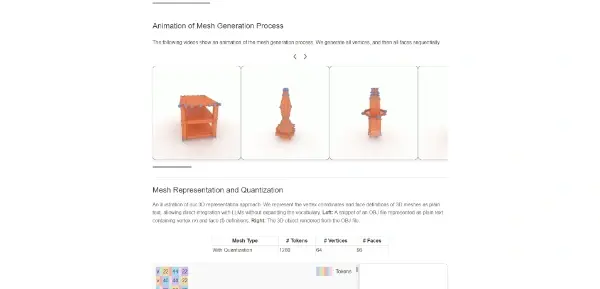LLaMA-Mesh

An AI model that generates 3D objects from text descriptions. It unifies natural language and 3D modeling to create complex and precise meshes
LLaMA-Mesh: Bridging the Gap Between Text and 3D Models
LLaMA-Mesh represents a significant advancement in AI-powered 3D modeling, offering a novel approach to generating intricate three-dimensional objects directly from natural language descriptions. This innovative tool unifies the worlds of natural language processing and 3D modeling, enabling users to create complex and precise meshes without the need for extensive 3D modeling expertise. This article delves into the capabilities, applications, and comparative advantages of LLaMA-Mesh.
What LLaMA-Mesh Does
LLaMA-Mesh's core function is the generation of 3D meshes from text prompts. Users input a descriptive text string detailing the desired object, and the AI processes this information to generate a corresponding 3D model. The model is represented as a mesh – a collection of interconnected polygons – forming the object's shape and structure. The system's strength lies in its ability to handle complex and nuanced descriptions, resulting in high-fidelity, detailed 3D outputs.
Main Features and Benefits
- Text-to-Mesh Generation: The primary feature is the direct translation of natural language instructions into 3D meshes. This eliminates the need for manual modeling, significantly reducing time and effort.
- High-Fidelity Output: LLaMA-Mesh strives for accuracy and detail in its generated meshes, producing models that are close representations of the textual descriptions.
- Ease of Use: The intuitive input method—simply typing a description—makes the tool accessible to a wide range of users, regardless of their 3D modeling skills.
- Complex Geometry Handling: LLaMA-Mesh is designed to handle complex shapes and intricate details, going beyond simple primitives.
- Open-Source Nature (Implied): While not explicitly stated, the free pricing suggests a potential open-source or freely accessible nature, fostering community development and expansion.
Use Cases and Applications
The applications of LLaMA-Mesh are diverse and span various industries:
- Rapid Prototyping: Designers and engineers can quickly create 3D prototypes based on textual specifications, accelerating the design process.
- Game Development: Level designers can generate assets efficiently based on textual descriptions of environments and objects.
- Architectural Visualization: Architects can rapidly create preliminary 3D models for building designs from textual plans.
- Virtual and Augmented Reality: LLaMA-Mesh can facilitate the creation of 3D assets for VR and AR applications.
- Education and Training: The tool can be used in educational settings to teach 3D modeling concepts in an accessible and engaging way.
Comparison to Similar Tools
LLaMA-Mesh distinguishes itself from other text-to-3D tools through a combination of factors. While many tools focus on generating simpler shapes or require more structured input formats, LLaMA-Mesh aims for high-fidelity outputs from natural language descriptions. A direct comparison would require analyzing its performance against specific competitors (e.g., other text-to-3D generators), comparing factors such as detail level, accuracy, and ease of use. However, the ability to handle complex geometry and the free accessibility are key differentiators.
Pricing Information
LLaMA-Mesh is currently offered free of charge. This open and accessible pricing model significantly broadens its potential user base and accelerates its development and adoption.
Disclaimer: Since specific details on the model's limitations, performance benchmarks, and precise capabilities may not be fully available, this article presents a general overview based on the provided information. Further investigation and hands-on experience would be necessary for a complete assessment.